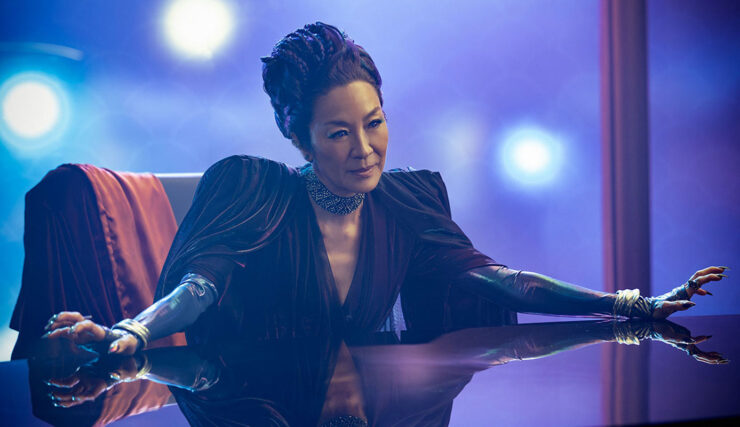
reactormag.com
“Let’s get messy” — Star Trek: Section 31
Movies & TV
Star Trek: Section 31
“Let’s get messy” — Star Trek: Section 31
For a story about a shadowy black-ops organization, there is surprisingly little shadowy black-ops…
By Keith R.A. DeCandido
|
Published on January 24, 2025
Credit: Jan Thijs/Paramount+
Comment
0
Share New
Share
Credit: Jan Thijs/Paramount+
I went into Section 31 with low expectations. I figured that it would be fun to watch Michelle Yeoh—because it’s always fun to watch Michelle Yeoh—and that the movie would annoy me otherwise because the very concept of Section 31 is stupid and wrongheaded and doesn’t belong in the Star Trek universe. And since I knew that it would be taking place in the early twenty-fourth century—the era between the end of the original series movies and before the launch of The Next Generation (there’s about seven decades of story time between The Undiscovered Country and “Encounter at Farpoint”)—I also knew that the movie would likely not do the one thing I wanted it to do, which is rid the Trek universe of S31 forever.
S31 was introduced in the Deep Space Nine episode “Inquisition” as a shadowy black-ops organization that operated outside the mainstream of the Federation. Every time they appeared on DS9 after that, it was clear that S31 was evil and rotten and needed to be gotten rid of. They did things like manipulate Romulan politics and commit genocide, and do other things that Star Trek protagonists are usually in the position of stopping and keeping from happening, even if it’s from people nominally on their side (e.g., the original series’ “The Omega Glory,” TNG’s “The Pegasus,” Voyager’s “Equinox,” Discovery’s first season). One of the many many many sins committed by the writers of Picard season three was giving us S31’s torture of changelings (one of the things that was directly responsible for the horrible things that happened in the season) and our heroes not confronting them and exposing them and doing something to make them see justice for that horrible act, which is contrary to the entire damn point of Star Trek as a storytelling vehicle.
Before folks go down into the comments that tell me that S31 is more realistic, please resist that urge for two reasons. One, it’s not realistic, because another of the big problems with S31 is that they seem to have super powers that keep them from ever being wrong and always being able to accomplish tremendous things with incredibly unrealistic perfection. (To give one example, in DS9’s “Inter Arma Enim Silent Leges,” Sloan manages to sneak onto and off a military base in the middle of a war twice, get himself assigned to a sensitive mission, corrupt a Starfleet admiral, fake his own death, and get away from the most secure location in the Romulan Empire, with no explanation of how he does any of this, nor why S31 doesn’t share this miraculous technology with anyone else, which would be of way more benefit to the Federation than any of the bullshit they do.)
Two, Star Trek is aspirational fiction, not realistic fiction. If I want stark realism in my science fiction television, I have other places for that: The Expanse, Babylon 5, the Stargate franchise, etc. Trek has always—always—been about humanity at its best, or at least trying its best. Things like S31 are what the protagonists in Trek fight against, not what they work with or accept or anything like that.
Credit: Jan Thijs/Paramount+
And then I sat down at watched Section 31, and while the first part was true—it was, indeed, fun to watch Yeoh, as ever—the second part wasn’t, entirely.
Because this isn’t a movie about Section 31.
Oh, sure, it claims to be S31, but there isn’t anything in this movie that requires it to be the shadowy black-ops organization that does evil things in the name of preserving the Federation, as we’ve seen it in those DS9 episodes, in Enterprise’s fourth season, in Star Trek Into Darkness, in Picard’s third season, in Discovery’s second season, and so on.
No, what we get, instead, is a Mission: Impossible movie. More like the Tom Cruise movies than the 1960s TV show, though with nobody clinging to an airplane or running fast down an unconvincingly empty stretch of straight-line pathway.
But all they’re doing is retrieving a bit of tech from a dodgy buyer. That’s it. This isn’t a Section 31 story, it’s a Starfleet Intelligence story. There’s no need for the deniability required by S31 (and, to be fair, by an M:I story, but that also doesn’t take place in a utopian future, but the modern U.S., which is, um, not utopian by any stretch).
Instead, we get a ragtag team of misfits who go on an adventure to stop an evil Maguffin from blowing up the galaxy. And the only reason we’re given as to why this is S31 instead of, say, a team of Starfleet personnel undercover or something is that it’s outside Federation space, so Starfleet can’t go there. This has been a weird thing we’ve seen on the Secret Hideout shows of late, declaring that Starfleet can’t leave Federation borders, which is a hundred percent at odds with the entire point of Starfleet. Remember, “to boldly go where no one has gone before”? Can’t do that if you’re stuck inside the Federation, can you?
Credit: Jan Thijs/Paramount+
Along the way, we get some backstory on Yeoh’s Emperor Philippa Georgiou. The movie opens in the Mirror Universe, where the Terran Empire is picking a new emperor, a process that is pretty much the Hunger Games: a bunch of young people are all in a contest to see who is worthy. When it’s down to two people—Georgiou (played as a youth by Miku Martineau) and San (James Huang as a youth, James Hiroyuki Liao as a grownup)—they have a final test to perform. They have to kill their entire family, which Georgiou does, but San does not. San’s entire village is destroyed. This is basically the Family Extermination/Betrayal of Offspring trope that you see all over the very Asian cinema where Yeoh cut her teeth, especially in stories about antiheroes and/or villains. (Georgiou certainly qualifies for that…)
Georgiou keeps San as a slave when she’s emperor, and then later he died by poisoning himself, the same poison Georgiou used to kill her family. Except later we find out he didn’t really die, and he’s now the bad guy.
The thing the S31 team has been assigned to nab is taken by a mysterious figure who later turns out to be San. The team then has to track him down and stop him from using the Maguffin—which is a super-weapon that Georgiou created as a deterrent and, oh yeah, has no way to stop—on the mainline universe, thus paving the way for the Terran Empire to cross over and conquer the Federation.
(The script, by the way, gives you just enough information to be confusing. Georgiou’s entire time-travel odyssey on Discovery is ignored, both her jumping to the future and her Guardian-of-Forever-enforced trip to the past. There’s no explanation of why she’s in the early twenty-fourth century instead of the middle twenty-third, and nobody asks why she’s not noticeably older even though many decades of time have passed.)
The team includes an Augment (Omari Hardwick, evincing no interest in giving his character anything resembling a personality), a chameloid (Sam Richardson, who, bizarrely, hardly ever changes shape at any point in the movie, so why is he there, exactly?), a cyborg (Rob Kazinsky, who is at least entertainingly violent), a Deltan (Humberly Gonzalez, who is killed early on to show that there are stakes), and a tiny bug who is riding inside an android that looks like a Vulcan (Sven Ruygrok, who substitutes changing accents for acting). They also have a Starfleet chaperone: Lieutenant Rachel Garrett, who we know will eventually become Captain Rachel Garrett of the U.S.S. Enterprise NCC-1701-C, until she dies and that ship is destroyed saving a bunch of Klingons on Narendra III (as seen in TNG’s “Yesterday’s Enterprise,” where she was played by Tricia O’Neill). Garrett here is played by Kacey Rohl, who does the best she can with a role that is saddled with ridiculously inconsistent writing, as she goes from being the only grownup in the room to a giddy chaos goblin with no explanation. Though I do like that she helps save the day in true Starfleet fashion by science-ing the shit out of something, in this case a child’s doll that can be turned into an explosive with the right technobabble.
Credit: Jan Thijs/Paramount+
The story makes occasional feeble attempts at making sense, but mostly just contrives excuses to go from set piece to set piece. We’ve got Georgiou and San (though we don’t know it’s him at this point) both being out of phase and having a chase-and-fight scene that’s very well staged and fun to watch. There’s the hot-wiring of a garbage scow to go after San when the team’s actual ship is destroyed. There’s the back-and-forth of trying to figure out who the mole is in the team, even though it’s ridiculously easy to figure it out. There’s the chameloid’s snotty commentary, which is at least well delivered by the always-reliable Richardson. And both Yeoh and Liao sell the angst and anger and frustration of the doomed lovers.
In the end we get what many may view as a continuity flub, but which really isn’t. What we were told of the Mirror Universe’s history between its introduction in the original series’ “Mirror, Mirror” and Kira and Bashir’s trip there a century later in DS9’s “Crossover” is that the Terran Empire fell because Spock tried to do as Kirk urged him in the original series episode and attempt to reform the empire. That led to the Klingon-Cardassian Alliance stepping in and conquering them. However that information came from Intendant Kira of Bajor who is, um, not a reliable narrator and has every reason to interpret history in a way that makes the Alliance look good and the Terran Empire look bad. Because what we get here, instead, is Georgiou shooting her superweapon—called Godsend, and there’s a cute exchange where the characters try to determine if it’s “God’s end” or “God send”—through the rift between universes to wipe out the Terran Empire once and for all.
In the end, the team is mostly still intact—the tiny bug’s wife replaces her husband on the team, and she’s pissed at her mate—and ready to go on more missions. Well, except for the poor Deltan, who was disintegrated, and pretty much forgotten by the final hour of the film. Of all the Trek tropes this movie had to dig into, it was the redshirt trope. Sigh.
This movie is ultimately a whole lot of meh. Yeoh is fun to watch, and the action is directed decently by Olatunde Osunsanmi (with his usual overuse of spurting flames), but that’s pretty much all there is to it. Usually, the saving grace of any Trek production is the characters, but aside from a bit of backstory that explains why Georgiou was so desperate for found family in Discovery (because she had to kill her blood family in order to rise to power), there’s not much characterization here. They’re all types, not people, and neither Craig Sweeny’s script nor the mediocre acting does anything to elevate them beyond that.
Oh, and Jamie Lee Curtis makes a cameo at the end as “Control,” who is apparently the head of S31. This would’ve been of much more moment if this was the TV series it was originally developed as rather than the movie it mutated into when Yeoh became too famous to have time to star in a TV show. (Well, this TV show. I mean, she had time to be in The Brothers Sun…) Instead, especially coming as it does at the end of this mediocre movie, it just inspires a shrug.[end-mark]
The post “Let’s get messy” — <i>Star Trek: Section 31</i> appeared first on Reactor.














